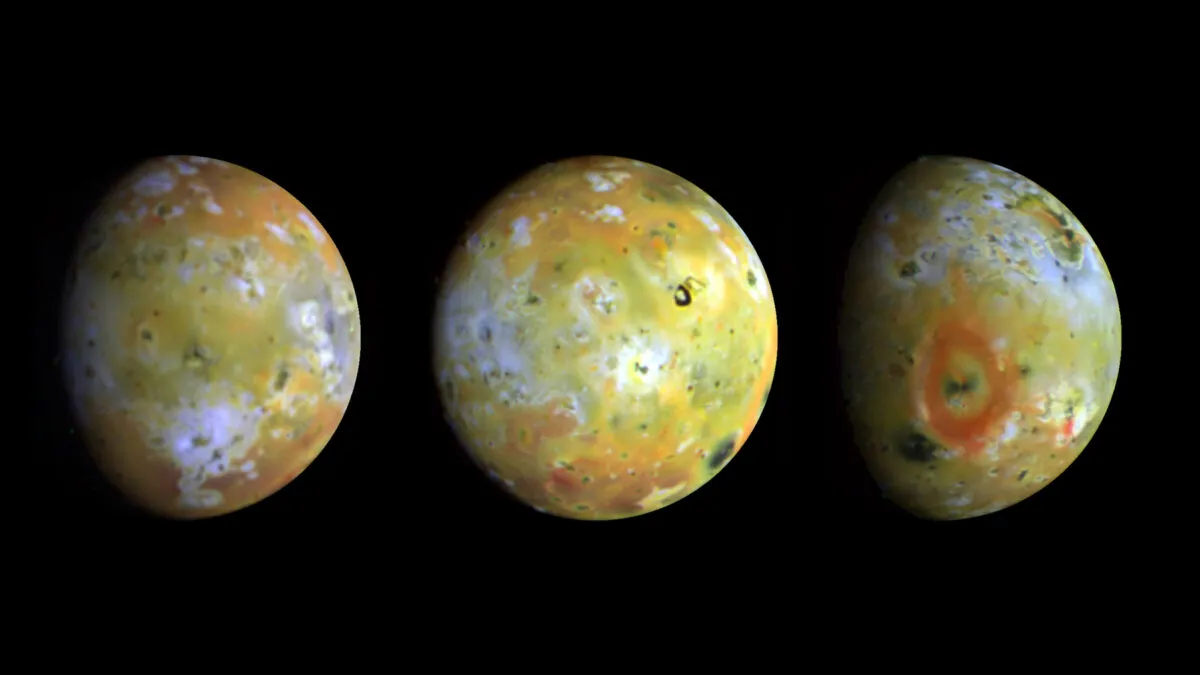"It looks like a mouldy pizza! The colours of Io, caused by sulphur dioxide at various temperatures, range from black to orange to yellow to blue."
When we spoke to NASA planetary scientist and Voyager mission imager Linda Morabito back in 2017, we got an amazing insight into how she discovered and confirmed active volcanoes on Jupiter's Moon Io, and this was the bit that stood out most.

Io is the most volcanic place in the Solar System, and if you look at images of the Jovian satellite sent back by the Voyager spacecraft, Morabito was right.
"Mouldy pizza" just about sums it up.
Now, some 45 years later, NASA's latest Jupiter mission – the Juno spacecraft – has worked out what's going on beneath Io's surface.

What Juno discovered at Io
NASA's Juno spacecraft arrived at the Jupiter system on 4 July 2016 and has been observing the planet and its moons ever since.
And it may just have discovered why and how Io became the most volcanic body in the Solar System.
Juno mission scientists have found that the volcanoes on Io are likely powered by their own individual chambers of hot magma, rather than an entire ocean of magma.
A paper on the source of Io’s volcanism was published on 12 December 2024 in journal Nature.
Io, from small dot to volcanic close-up
We have to go all the way back to the time of Galileo for the first confirmed observation of Jupiter's moon Io.
Galileo discovered Io in 1610, when he saw it and Jupiter's other Galilean Moons (as they're now known) as pinpricks of light through his telescope.
Fast-forward to 1979, when imaging scientist Linda Morabito of NASA’s Jet Propulsion Laboratory identified a volcanic plume on Io in an image captured by the Voyager 1 spacecraft.

"Since Morabito’s discovery, planetary scientists have wondered how the volcanoes were fed from the lava underneath the surface," says Scott Bolton, Juno principal investigator from the Southwest Research Institute in San Antonio.
"Was there a shallow ocean of white-hot magma fueling the volcanoes, or was their source more localised?
"We knew data from Juno’s two very close flybys could give us some insights on how this tortured moon actually worked."

Juno's flyby of Io
Juno flew close by Io in December 2023 and February 2024, scraping by the moon at a distance of just 1,500km (930 miles) above its surface.
In April 2024, scientists announced that Juno saw a lake of cooling lava on Io during the flybys.
Juno data was also used to measure Io’s gravitational pull, by tracking how it affected the spacecraft’s acceleration.
Information gathered during the close approaches enabled scientists to learn more about the effect of something called 'tidal flexing'.

Io has an elliptical – or egg-shaped – orbit around Jupiter, which takes 42.5 hours to complete.
As it swings close by, then far away from Jupiter, Io is squashed and squeezed by the gas giant's changing gravitational tug.
This 'tidal flexing' generates internal heat within the moon.
"Constant flexing creates immense energy, which literally melts portions of Io’s interior," says Bolton.
"If Io has a global magma ocean, we knew the signature of its tidal deformation would be much larger than a more rigid, mostly solid interior.
"Thus, depending on the results from Juno’s probing of Io’s gravity field, we would be able to tell if a global magma ocean was hiding beneath its surface."

Combining the data with information gained from previous missions to Jupiter and ground-based telescopes, the scientists found the picture was consistent with Io not having a shallow global magma ocean.
"Juno’s discovery that tidal forces do not always create global magma oceans does more than prompt us to rethink what we know about Io’s interior," says lead author Ryan Park, a Juno co-investigator and supervisor of the Solar System Dynamics Group at JPL.
"It has implications for our understanding of other moons, such as Enceladus and Europa, and even exoplanets and super-Earths. Our new findings provide an opportunity to rethink what we know about planetary formation and evolution."
Read the full paper at www.nature.com/articles/s41586-024-08442-5.epdf

